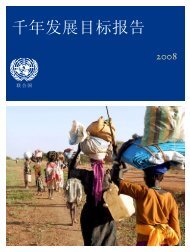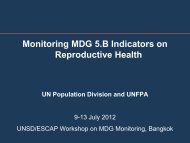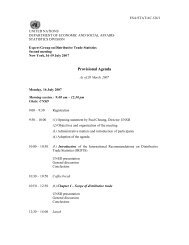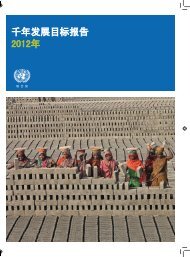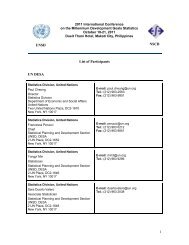demographic yearbook annuaire demographique 1951
demographic yearbook annuaire demographique 1951
demographic yearbook annuaire demographique 1951
Create successful ePaper yourself
Turn your PDF publications into a flip-book with our unique Google optimized e-Paper software.
available for 1930) and in 5 cases the percentage change<br />
was reckoned to the year 1948 or 1949 (later data not<br />
being available).<br />
These data indicate that among countries that had crude<br />
rates of 15 or more per 1,000 in 1930, almost half showed<br />
decreases of over 40 per cent and most of the remainder<br />
showed decreases of 20 to 39 per cent.<br />
The areas included in the table are even less representative<br />
of the world situation than those included in table C.<br />
However, they have a wide enough spread, from the geographic<br />
and ethnic points of view, to indicate that significant<br />
progress has been made during the past two decades in the<br />
reduction of mortality. Relative decreases among the areas<br />
of high mortality in 1930 are large enough to transcend the<br />
considerations of change in age composition discussed above<br />
and leave no doubt that a genuine decrease has occurred.<br />
Even among the areas for which the statistics are ofdoubtful<br />
accuracy or are acknowledged to be deficient, the changes<br />
indicated have some significance. Presumably coverage of<br />
these populations has improved over the period under consideration.<br />
If so, such decreases as the statistics show may<br />
actually understate the absolute decline in the crude rate,<br />
though the relative decline may in some cases be overstated.<br />
Among the 72 areas for which data are available at both the<br />
beginning and the end of the period (including the 44 areas<br />
treated in table D) 14 reported declines of 40 per cent or<br />
more; 34 reported declines of 30 per cent or more. Most of<br />
these are areas with initial rates approaching or surpassing<br />
20 per 1,000.<br />
As mentioned earlier, the African population is scarcely<br />
touched in this analysis. Two examples of recent findings<br />
may therefore be cited. In the sample census of the African<br />
population of Southern Rhodesia, data on births and deaths<br />
for the year ending 31 August 1948 were collected. These<br />
data yield an estimated crude death rate of 18.1 per 1,000. 1<br />
Preliminary results of a recent study among the tribal Arabs<br />
of Libya indicate a crude death rate of about 40 per 1,000.<br />
These two observations do not give an adequate basis for<br />
generalization. They serve, rather, to underline the need for<br />
further information.<br />
Sufficient data for a more detailed consideration of general<br />
mortality trends in each major region of the world are<br />
contained in the tables of this Yearbook, but restrictions of<br />
time and space have made it necessary to confine the present<br />
TABLE D<br />
Distribution of 44 areas by the level of the crude death rate<br />
in 1930 and the percentage decrease 1930-1950<br />
Number oj areaS by percentage<br />
decrease 1930-1950<br />
Crude rate All Under 20 20-39 40per cent<br />
in 1930 areas per cent per cent or over<br />
All classes. . . . . . . . . .. 44 21 15 8<br />
Under 10.0......... 7 16 1<br />
10.0-14.9 ........... 18 213 4 1<br />
15.0-19.9........... 11 1 8 2<br />
20.0-24.9........... 5 1 1 3<br />
25.0 or over......... 3 1 2<br />
1 Including 3 cases in which the rate increased.<br />
2 Including 1 case in which the rate increased.<br />
1 See "Sample Census of the Indigenous African Population,"<br />
Economic and Statistical Bulletins oj Southern Rhodesia, Vol. XVII, No.8,<br />
Central African Statistical Office, Salisbury, 21 July 1949. Pages 7-12.<br />
treatment to broad comparisons between 1930-1932 and<br />
1948-1950 for the world as a whole. Interesting variations<br />
during the intervening period and among different parts of<br />
the world may be found in the data here presented. They<br />
raise some problems of analysis and interpretation, but they<br />
are not likely to invalidate the general import of the findings<br />
reported above.<br />
An important aspect of these findings is their implications<br />
with respect to population growth. Many of the areas which<br />
have reported significant declines in the death rate show<br />
little or no change in the birth rate. With birth rates<br />
approaching 40 per 1,000 and death rates dropping to the<br />
neighborhood of 10 to 15 per 1,000, annual rates of natural<br />
increase will range between 2.5 and 3 per cent. The official<br />
statistics indicate such rates in an increasing number of<br />
countries. At the rate of 2.5 per cent per year, a population<br />
will double in 28 years. While the conquest of mortality<br />
makes a striking contribution to human welfare, the prospect<br />
of such rapid population growth calls for some concern if<br />
that welfare is to be protected and enhanced.<br />
MORTALITY BY AGE AND SEX<br />
The scope of an analysis of trends in mortality specific for<br />
age and sex is necessarily more limited than that of an<br />
analysis of crude death rates. Data on deaths classified by<br />
characteristics of the decedent and corresponding statistics<br />
of the population on which to base rates are not so widely<br />
available as are the data required for the computation of<br />
crude rates. Nevertheless, it is only on the basis of such<br />
detailed information that differences and changes in mortality<br />
can be truly measured or well understood. Furthermore,<br />
a great deal can be inferred, from the information<br />
that is available, concerning areas for which statistics do<br />
not yet exist.<br />
As concerns infant mortality rates, which are based on<br />
the number of live births and therefore do not require<br />
statistics of the population classified by age, the requisite<br />
data are more extensively available than is the case for other<br />
age groups. Hence it is convenient to consider infant mortality<br />
separately, then mortality at the later ages.<br />
. Infant mortality. The infant mortality rate (here defined as<br />
the number of deaths under 1 year of age per 1,000 live<br />
births, both items referring to the same year) is widely used<br />
as an indication of the general health and well-being of a<br />
population. Because of the vulnerability of the human infant<br />
to the ravages of disease, malnutrition, poor medical care<br />
etc., this rate reflects rather faithfully the living conditions<br />
of the general population. It responds quickly and perceptibly<br />
to improved conditions. Rapid declines in the crude<br />
death rate are often attributable mainly to a reduction in<br />
infant mortality.<br />
In interpreting the infant mortality rates presented in<br />
table 19, the usual caution as to the reliability of the basic<br />
figures on infant deaths and live births should always be<br />
kept in mind. The completeness of registration of live births<br />
and of infant deaths varies from country to country, and<br />
within the same country the coverage and tl;1e accuracy of<br />
data collected are not necessarily the same for both these<br />
items. Distortions of the rates are therefore to be expected<br />
in all countries or areas in which the basic statistical data<br />
are not completely and accurately recorded. If, for example,<br />
births are completely registered while some infant deaths<br />
escape registration, the resulting rate understates the actual<br />
mortality. Overstatement occurs if infant deaths are prop-<br />
12







